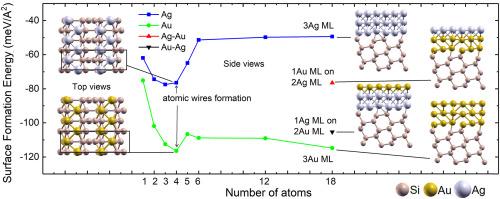Si (113)-1x1表面银和金沉积的第一性原理研究
IF 2.4
4区 物理与天体物理
Q3 PHYSICS, CONDENSED MATTER
引用次数: 0
摘要
在密度泛函理论(DFT)的基础上,利用从头算方法研究了银(Ag)和金(Au)在高折射率硅(113)表面的沉积。银和金的浓度从1个原子到3个单层(MLs)不等。采用表面形成能(SFE)形式确定了原子结构的稳定性。当4个金属原子沉积在硅表面时,一种可能的稳定原子结构是形成之字形原子线,其中Au原子线更稳定。1、2、3ml薄膜均形成稳定的结构,其中Au薄膜表现出较好的能量稳定性。用态密度(DOS)和投影态密度(pDOS)研究了电子性质。原子线之字形的实验结果表明,电荷输运可能是由金属原子下面的硅原子介导的。在Si (113)-1x1表面形成的金属结构可用于欧姆触点,可用于纳米电子工业。本文章由计算机程序翻译,如有差异,请以英文原文为准。

On the Ag and Au deposition on the Si (113)-1x1 surface: First principles studies
Silver (Ag) and gold (Au) deposition on the high index silicon (113) surface is investigated using ab-initio calculations, within the density functional theory (DFT). Ag and Au concentrations are varied from 1 atom up to 3 monolayers (MLs). The atomic structure stability is determined by applying the surface formation energy (SFE) formalism. When 4 metal atoms are deposited on the silicon surface, one possible stable atomic structure is the zigzag atomic wire formation, with the Au atomic wire being more stable. The 1, 2 and 3 MLs thin film form all stable structures, with those of Au displaying better energetic stability. Electronic properties are studied in terms of the density of states (DOS) and projected density of states (pDOS). Results of the zigzag atomic wires indicate that charge transport may take place mediated by the silicon atoms underneath the metal atoms. The metal structure formation on top of the Si (113)-1x1 may be applied in ohmic contacts, which may be used in the nano-electronic industry.
求助全文
通过发布文献求助,成功后即可免费获取论文全文。
去求助
来源期刊

Solid State Communications
物理-物理:凝聚态物理
CiteScore
3.40
自引率
4.80%
发文量
287
审稿时长
51 days
期刊介绍:
Solid State Communications is an international medium for the publication of short communications and original research articles on significant developments in condensed matter science, giving scientists immediate access to important, recently completed work. The journal publishes original experimental and theoretical research on the physical and chemical properties of solids and other condensed systems and also on their preparation. The submission of manuscripts reporting research on the basic physics of materials science and devices, as well as of state-of-the-art microstructures and nanostructures, is encouraged.
A coherent quantitative treatment emphasizing new physics is expected rather than a simple accumulation of experimental data. Consistent with these aims, the short communications should be kept concise and short, usually not longer than six printed pages. The number of figures and tables should also be kept to a minimum. Solid State Communications now also welcomes original research articles without length restrictions.
The Fast-Track section of Solid State Communications is the venue for very rapid publication of short communications on significant developments in condensed matter science. The goal is to offer the broad condensed matter community quick and immediate access to publish recently completed papers in research areas that are rapidly evolving and in which there are developments with great potential impact.
 求助内容:
求助内容: 应助结果提醒方式:
应助结果提醒方式:


